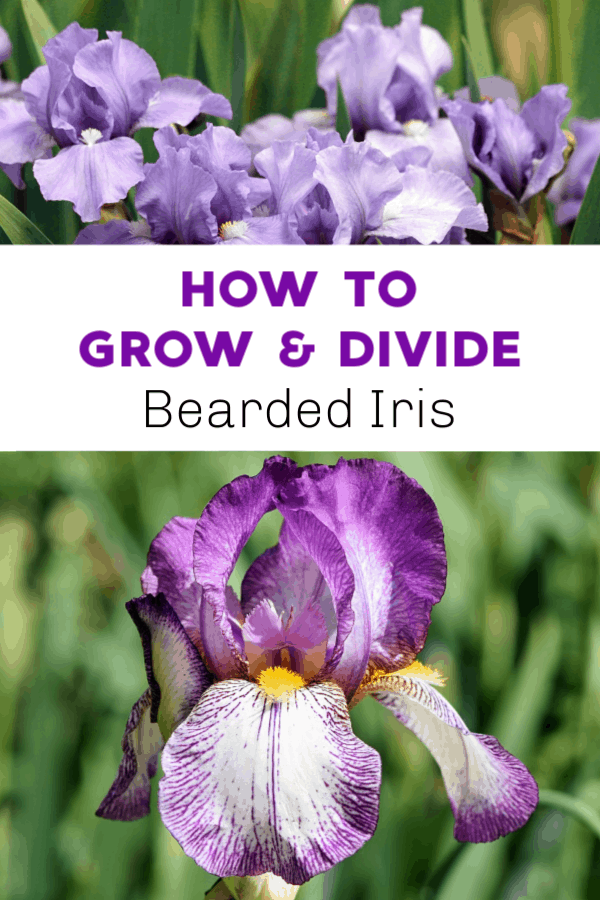
By Julie Christensen
Like lilacs, bearded irises have been around for a long time. These classic garden plants, sometimes known as “flags,” deserve a place in every garden. They produce beautiful blooms from spring to mid-summer and take almost no maintenance.
Bearded irises (Iris germanica) grow almost everywhere in the U.S. Hardy in USDA zones 3 through 9, they need at least a bit of frost during the winter to break dormancy in the spring. Bearded irises aren’t bulb plants, but they form from tubers, or soft, fleshy roots. Note that care is different for beardless irises, so be sure you know which kind you have.
Planting and Growing Bearded Iris
Bearded iris grows and blooms best in a location that gets at least six to eight hours of sunlight every day. In hot climates, a location with afternoon shade can work well. Plant bearded irises from late summer to early fall. Plant them at least six weeks before the first fall frost though so roots become well established.
When planting bearded irises, inspect the tubers first, and throw away any that are soft, dark or mushy. An off-odor can also indicate rot or disease. Irises aren’t particular about soil, although it must be well-draining. They grow best in light, loamy soil with a pH near neutral, although they’ll tolerate slightly acidic and alkaline soils.
Irises need good air circulation so plant them at least 18 to 24 inches apart. Plant the tubers so they sit just at soil level. In hot climates, you can plant them slightly deeper, but planting them too deeply will encourage lots of vegetative growth and few flowers. Water the soil frequently immediately after planting as the roots become established.
Once the roots are established, reduce watering to once or twice per week, or just enough to keep the soil moist 3 inches beneath the surface. Overwatering is a leading cause of iris failure and promotes root rot diseases. Mulch, usually a good idea in the garden, is discouraged for irises because it keeps the soil moist.
Fertilize irises in spring and again after blooming with a low-nitrogen formula, such as 5-10-10, at a rate of 2 tablespoons per plant. Remove the spent flowers too. Allowing them to go to seed or form seedheads saps energy, reducing the blooms you’ll see in coming years.
Dividing Irises
Like many rhizome-forming plants, irises need regular division to remain vigorous. After three or four years, the main rhizomes wither and die. Newer side shoots form, but the main plant starts to decline. The plants may also become overcrowded and more prone to disease. By dividing irises every three to four years, your irises will remain healthy for years to come.
Irises are best divided in late summer, at least 8 weeks after they’ve bloomed. To divide irises, use a spade or garden fork to carefully lift them out of the soil. Try not to spear or cut the rhizomes. Cut the foliage back to 4 to 6 inches. This pruning might seem harsh, but it reduces transplant shock. The old iris rhizome will have many young rhizomes attached to it and each one will have its own set of leaves. Break off each of these young rhizomes, using your hands or a knife if needed.
Once the rhizomes are divided, examine each one. Young, healthy iris rhizomes are about ½ inch wide. They should be firm and have several leaves emerging from them. Discard those that are old and thick, especially if they have no top growth. Also discard those that are shrunken, shriveled or soft. Some gardeners wipe the rhizomes with a solution of 1 part chlorine bleach to 10 parts water to prevent disease problems. This strategy isn’t necessary in dry climates, but might be a good idea in a warm, humid area. Of course, it only works with rhizomes that are healthy to begin with.
Replant the healthy irises, spacing them 18 to 24 inches apart. Remember to plant them shallowly so the tops of the rhizomes are barely covered with earth.
For more information on growing and dividing bearded irises, visit the following links:
How to Plant and Grow Bearded Iris from the American Iris Society
Bearded Iris for the Home Landscape from North Carolina State University Extension
Julie Christensen learned about gardening on her grandfather’s farm and mother’s vegetable garden in southern Idaho. Today, she lives and gardens on the high plains of Colorado. When she’s not digging in the dirt, Julie writes about food, education, parenting and gardening.

My bearded irises are beautiful, but this year only the first bloom was good. Second blooms died without opening. Do you have any ideas? It did rain more than usual this year in Los Angeles. Pl help.